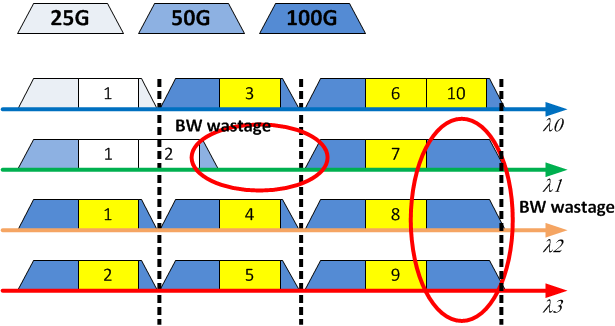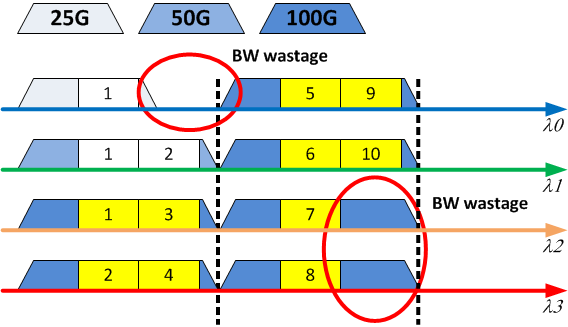Glen,Doesn't the 50G ONU use two lanes - US0 and US1? Maybe the subtle shades of blue aren't showing up properly on my monitor...JohnJohn E. Johnson, Ph.D.
Manager, III-V Component R&D | Fiber Optics Products Division
Broadcom
office: 484.397.2368 | mobile: 908.329.5710
9999 Hamilton Blvd. | Breinigsville, PA 18031 USA
john.johnson@xxxxxxxxxxxx | broadcom.comOn Thu, Jun 30, 2016 at 4:03 PM, Glen Kramer <000006d1020766de-dmarc-request@xxxxxxxx> wrote:Yes, that more or less captures it.The requirement for an ONU (LLID) to start and stop transmission on all enabled lanes at the same time is a show stopper, IMO. Here some figures to illustrate my concerns.In the figures, assume that a 25G ONU is scheduled to send 1 FEC codeword. At the same time, 50G ONU is scheduled to send 2 codewords. Now we have a 100G ONU that needs to send 10 FEC codewords (these codewords marked yellow in the figure).One way the scheduling can be done is to terminate 100G burst as soon as 25G stops transmission, and re-initiate 100G transmission on 3 lanes.Here, bandwidth is wasted after 50G ONU burst and at the end of 100G bursts on three lanes.Alternatively, OLT can try to be smarter and figure out that the wastage will be a little smaller if it terminates the 100G transmission not after the 25G ONU, but after the 50G ONU.This makes the situation only marginally better. What we really want is an "asynchronous execution", i.e., bursts on different lanes are not aligned, but rather a lane is grabbed by the scheduler as soon as it becomes available. For the same input scenario, the schedule will look like below - notice that transmissions are tightly packed and no bandwidth is wasted.Hope this makes my comments from the call clearer.Regards,GlenOn Thu, Jun 30, 2016 at 12:14 PM, Duane Remein <Duane.Remein@xxxxxxxxxx> wrote:Glen/Marek,
During the call today you both expressed concerns about fragmentation. Do the following two questions adequately capture your expressed concerns? If not please clarify.
1) In a multi-lane mixed capability network (mix of 25G, 50G & 100G ONUs) how would fragmenting avoid loss of capacity due to gaps between bursts?
2) In a multi-lane mixed capability network how could fragmenting allow an ONU that is bursting on X lanes expand its transmission to X+m (ex. go from 2 lane transmission to 4 lane transmission) smoothly?
Best Regards,
Duane
FutureWei Technologies Inc.
Director, Access R&D
Raleigh, NC


